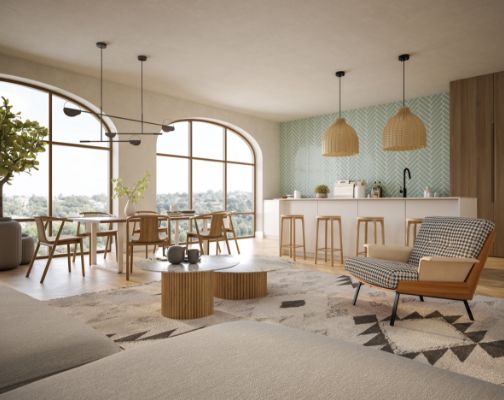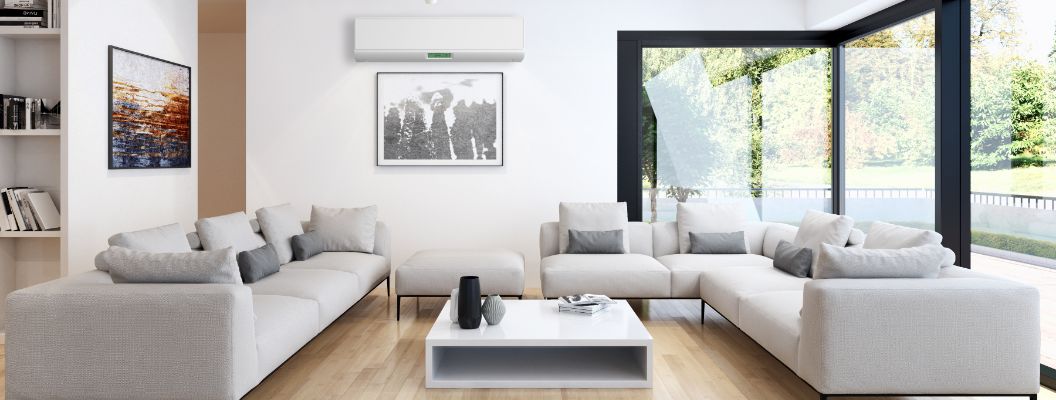A split system, as its name suggests, is split into two or more operating components. Typically, it consists of two operating components: the fan and evaporator, which is wall-mounted inside the building, and a compressor unit, which is placed outside the building either on the ground or hung on the wall.
Refrigerants inside the compressor then cool air from outside and pass them into the indoor unit though copper pipes, where the fan blows the chilled air around the room.
When used for heating, the system works inversely: it extracts cold air and blows warm air around the room.



Largely due to its simple design, there are many reasons why split system installation is an efficient heating and cooling choice. Some advantages include:
Split systems heat or cool spaces very quickly and are easy to control via a remote control.
Deliver warm or cool air only in the spaces where it’s needed and when it’s needed. No need to waste money heating unused spaces.
Indoor and outdoor units are connected by a couple of small pipes and electrical cables, so very little modification to your home is required to install fittings. No ductwork means reduced labour costs, quicker and a more affordable installation.
Because they are powered by electricity, split systems can be subsidised by solar power, making them a cost-effective solution for homes powered with the help of solar panels.
The indoor components of split system air conditioners contain filters which can easily be removed and cleaned by the owner – no call-outs are necessary to clean the indoor component.
Most split systems have heating and cooling capabilities as standard, so you can use one system year-round.
Many models will purify the air, so that dust and allergens are not circulated through the building.
The life expectancy of a split system air conditioner typically ranges from 10 to 15 years, depending on factors like usage frequency, local climate, and how well the unit is maintained. Regular servicing and cleaning, particularly of the filters, coils, and fans, can significantly enhance its lifespan – external conditions like exposure to extreme weather can also impact longevity.
By addressing any minor issues early and performing annual maintenance, homeowners can maximise their split system’s performance and lifespan, ensuring optimal efficiency and air quality over the years.
Excessive noise from a split system may indicate issues like loose components, clogged filters, or a malfunctioning fan. Start by checking and cleaning the air filters, as dirt buildup can obstruct airflow, causing the system to overwork.
Inspect the outdoor unit for debris or objects that may interfere with its function. If the noise persists, it could be due to worn parts or a refrigerant issue, requiring a technician’s inspection. Regular maintenance can help prevent these issues, keeping your system running smoothly and quietly.
Installation costs for a split system air conditioner vary widely, typically ranging from $600 to $1500, depending on unit capacity, home layout, and complexity. Additional costs may apply for electrical upgrades, wall reinforcements, or challenging installations, such as multi-storey or difficult-access areas.
Choosing a professional installation ensures proper placement, efficient operation, and compliance with safety standards. Tailored Heating & Cooling Solutions offers a free quote to give you a clearer idea of what to expect, making it easier to budget for both the unit and installation.
Installing a split system is not recommended as a DIY project. These systems require precise handling, electrical work, and proper refrigerant management, all best handled by licensed professionals. Improper installation can lead to efficiency issues, frequent repairs, and even void the manufacturer’s warranty.
Professionals ensure safe and correct setup, including proper placement and secure connections – by hiring an experienced technician, you’ll ensure your system performs efficiently, meets local regulations, and maintains its warranty.
A thermostat typically lasts about 10 years but should be replaced if you notice issues such as inaccurate temperature readings, a lack of response, or energy inefficiency. Modern thermostats, particularly smart models, offer energy-saving features like scheduling and remote control, which can improve overall system efficiency.
If you’re upgrading your air conditioning or experiencing inconsistent indoor temperatures, a thermostat upgrade could enhance comfort and energy savings. Regular maintenance can also help ensure your thermostat’s performance and prolong its lifespan.

Keeping You in the Loop: Our Latest News, Direct to Your Inbox!

At Tailored Solutions, we’re a bunch of forward-thinkers, innovators, and, admittedly, coffee enthusiasts, who believe that a comfortable home is the cornerstone of a happy life.
ARCTick Licence No: ARCTICK AU41000
